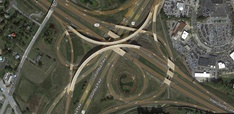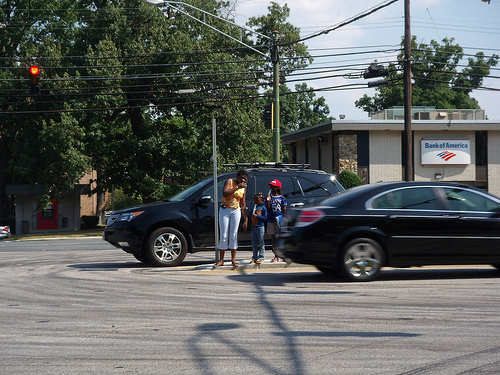Support grows for BRT in eastern Montgomery, but councilmembers are undecided

Route 29 interchange with the ICC. Image from Google Maps.
Montgomery County is currently deciding what projects to prioritize for its share of state transportation funds. But elected officials are divided over whether to support building new interchanges along Route 29 in East County, or a Bus Rapid Transit line instead.
Tomorrow, the County Council will discuss its transportation priority letter, which requests funding for specific projects from the state. The council’s Transportation and Environment committee has recommended taking a progressive shift to prioritize more bicycle, pedestrian, and transit projects.
Led by chair Roger Berliner and at-large councilmember Hans Riemer, the committee prioritized funding to extend the Corridor Cities Transitway to Clarksburg, WMATA’s Priority Corridors bus network, and funding to implement bicycle-pedestrian priority areas throughout the county. They also voted to remove three out of four proposed new interchanges on Route 29 in White Oak and Burtonsville.
Several interchanges have been built on the corridor between Silver Spring and Burtonsville in recent years, creating a partially closed-access highway between Route 198 and New Hampshire Avenue that narrows down to a typical, six-lane arterial south of New Hampshire Avenue, where Route 29 approaches downtown Silver Spring.
There have been plans on the books for years to add four additional interchanges north of White Oak, at Fairland and Musgrove roads, Tech Road, Stewart Lane, and Greencastle Road, which has the support of County Executive Ike Leggett. The total price tag? $344 million.
The problem is, the real bottleneck on Route 29 is south of all these intersections in the Four Corners neighborhood, where drivers queue to get on the Beltway. State and county planners know they will never widen Route 29 through Four Corners, meaning new interchanges will only speed more commuters to the bottleneck faster. The interchanges will also make pedestrian connections across the highway more difficult, while increasing the flow and speed of traffic in areas like Four Corners, reducing pedestrian safety.

A family tries to cross Route 29 at Stewart Lane, where an interchange is proposed. Photo by dan reed! on Flickr.
That’s why the council committee and the Planning Board both recommended removing additional interchanges from this year’s list. Route 29 is one of the 10 corridors in the county’s newly-approved BRT network, and Planning Department staff who ran models on the corridor suggested implementing BRT first, and then reviewing whether the interchanges are still needed. They estimate that an 11-mile BRT line between Silver Spring and Burtonsville would cost $351 million, similar to the three interchanges.
While Bus Rapid Transit is not yet ready for construction on Route 29, requesting funds for the three interchanges now would absorb a significant amount of state funds for years to come, making it more difficult to fund needed, high-quality transit in the corridor in the future.
A chart comparing the County Executive’s proposals and committee recommendations is on the last page of the council packet. At-large councilmember Nancy Floreen wants to see all four interchanges on 29, while the County Executive wants two: Fairland/Musgrove and Tech. It’s unclear where the rest of the Council stands on the issue, especially newly-appointed interim Councilmember Cherri Branson whose district (District 5) includes Route 29.
If you want to see Montgomery County prioritize Bus Rapid Transit and other sustainable transportation projects above decades-old, grade-separated interchanges, click here to send county leaders an email.
